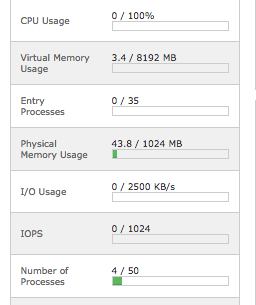Entry Processes and .htaccess
Overview
Overview
This article describes our experiences of dealing with a denial of service (DOS) type of attack through the use of the .htaccess file commonly available on web hosting environments. This article also discusses (or makes guesses at) reducing the mysterious "Entry Processes" count found on the cPanel side bar when managing your web site.
Problem History
- We had provided simple CGI and PHP scripts at our http://www.networksecuritytoolkit.org/ site.
- The scripts were simple and simply reported a short string (like: "66.198.240.15") indicating the IPv4 address of the client making the request.
- This simple service became very popular.
- Even though the scripts were extremely short, our original web hosting provider became upset with us due to the number of connections being made.
- We tried to appease our web hosting provider by disabling the service (removing the scripts and triggering 404 errors to all of our clients).
- While this prevented the service from running, it did not stop all of the incoming connections and the server handling the 404 (our web host provider was still not happy with us).
- We then modified our top level .htaccess file to reduce the load of handling 404 messages (still didn't make our web hosting provider happy).
- At this point we were at a loss of what to do as the continual pounding on the web server from outside requests for our simple IPv4 service would not stop.
The bottom line is that by providing a useful and simple service that many people had come to rely on we had essentially created a denial of service (DOS) upon ourselves as many machines throughout the internet are running unmanaged cron jobs that hit our service to request an IPv4 address. We were powerless to stop the external requests (short of moving to a new domain).
We tried moving our site to a new we hosting service as our current provider could offer us no help in resolving the issue (short of upgrading our site to a dedicated server).
Things were not much better at our new site.
- The new web hosting environment indicated the word "Unlimited" in much of their advertisement (this is common).
- However, our web site performance was terrible (pages would sometimes not load at all or only partially load).
- Using the cPanel interface at the new web hosting environment, we discovered that we were maxing out our "Entry Processes" count (we had a limit of 35).
- Through a lot of trial and error and guessing, we determined that we were hitting this "Entry Processes" limit due to 404 errors from incoming requests for PHP and CGI scripts that did not exist on our system.
- At this point we were quite frustrated and sent in a help request to our new web hosting provider. Basically, we wanted to know how to prevent the "Entry Processes" limit from maxing out when clients sent bad requests to our site. It seemed quite unfair to us that our site could be rendered unusable simply by having requests for documents not available at our site.
The .htaccess File
While waiting for our web host provider to offer a suggestion, we started experimenting with the ~/public_html/.htaccess file that the web host provider enables in accounts. This file can be used to "tweak" how Apache handles requests from the outside world.
We decided to first try minimizing the 404 load on the server by telling Apache to just echo a message (instead of looking for a document to send back) with the following:
ErrorDocument 404 "<H1>Page not found</H1>"
While this worked and reduced the load a bit, it did not help with the "Entry Processes" count that was making our web site unusable.
We next tried adding RedirectMatch directives to our .htaccess file:
ErrorDocument 404 "<H1>Page not found</H1>" RedirectMatch temp /ip.php$ /no-ip.txt RedirectMatch temp /ip.cgi$ /no-ip.txt
The above rules instructed Apache to send back a simple text file (http://www.networksecuritytoolkit.org/no-ip.txt) anytime a request was made for http://www.networksecuritytoolkit.org/nst/tools/ip.php or http://www.networksecuritytoolkit.org/nst/cgi-bin/ip.cgi (the two URLs that the outside world was pounding).
Low and behold that fixed the problem! Immediately our "Entry Processes" count dropped to 0 and our site was usable again.
